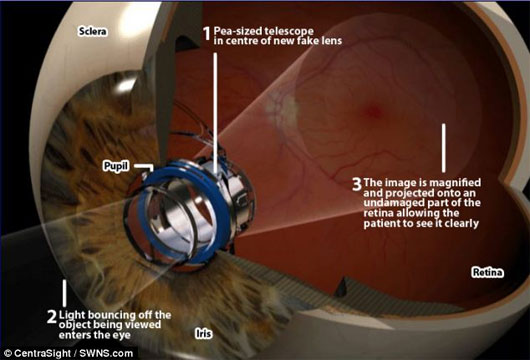Technological breakthroughs in telescope in the eye
A British grandmother saw her husband's face for the first time after 15 years thanks to a tiny telescope implanted in her eyes.
Margaret Ward, 90, lost her sight in 1999 due to the degenerative disease in the late stage. The disease caused her to completely lose her central vision in her left eye and was only visible in one corner of her right eye. Consequently, she could not cook, read newspapers or recognize relatives.
But she became one of seven people in England who had a breakthrough surgery. During this surgery, she implanted a pea-sized telescope into her right eye.
The device is called Implantable Miniature Telescope , of CentraSight.

The telescope replaces the crystal lobe that magnifies the image onto the healthy retina.(Photo: Daily mail)
The operation was performed with local anesthesia including taking out the natural lens and replacing it with a tiny telescope.
The lens will magnify the object 3 times and project an image of the object onto the healthy retina instead of the affected area.
The patient will then use the implanted eye for central vision and the other eye for peripheral vision.
Ms. Ward said: 'Now I can see the faces of my great-grandchildren and this is really exciting'.
Macular degeneration is a painless eye disease that often leads to a gradual loss of central vision, but can sometimes cause visual acuity to drop rapidly.
The disease makes the central vision more blurry and makes it difficult for the patient to read and recognize the face of the acquaintance.
The disease usually affects both eyes but the rate of progression may vary between eyes. The disease does not affect peripheral vision, so does not cause complete blindness.
The disease occurs when the macula - the part of the eye responsible for central vision - becomes less effective and most common in the elderly.
- Breakthroughs are expected
- 7 medical breakthroughs in 2017 make sure you are admiring
- 5 world medicine breakthroughs 2009
- China will build the second giant telescope to find aliens
- Hale telescope - Legend of the telescope world
- NASA is developing a telescope capable of saving humanity
- Commencement of the world's largest telescope project in Chile
- NASA builds the world's most powerful telescope
- Top 'breakthroughs' in science and technology in 2016
- 10 most beautiful Moon maps over the ages
- Breakthroughs in the field of microsurgery
- Top 10 scientific and technological achievements in 2011
 Green tea cleans teeth better than mouthwash?
Green tea cleans teeth better than mouthwash? Death kiss: This is why you should not let anyone kiss your baby's lips
Death kiss: This is why you should not let anyone kiss your baby's lips What is salmonellosis?
What is salmonellosis? Caution should be exercised when using aloe vera through eating and drinking
Caution should be exercised when using aloe vera through eating and drinking